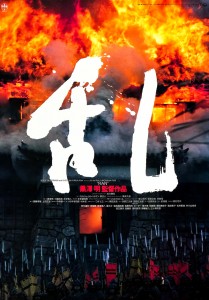
"Ran" Japanese Theatrical Poster
AKA: Chaos
Director: Akira Kurosawa
Writer: Akira Kurosawa, Hideo Oguni, Masato Ide
Producer: Serge Silverman, Masato Hara
Cast: Tatsuya Nakadai, Akira Terao, Jinpachi Nezu, Daisuke Ryu, Masayuki Yui, Kazuo Kato, Peter, Hitoshi Ueki, Jun Tazaki, Mieko Harada, Yoshiko Miyazaki, Norio Matsui
Running Time: 160 min.
By Kyle Warner
Throughout Akira Kurosawa’s illustrious career the director often adapted classic literature from overseas and transformed the stories into tales about Japan. Some of his favorite writers that he took the most inspiration from were Shakespeare, Dostoevsky, and Maxim Gorky, but it’s the Shakespeare adaptations that made for the most interesting films. Kurosawa did away with Shakespeare’s words but kept the tragic plots largely intact. Shakespeare’s Macbeth became Throne of Blood, a film about a samurai that commits murder in order to chase destiny. Hamlet was an inspiration for The Bad Sleep Well, a drama about a businessman carefully plotting his revenge against the executives responsible for his father’s death. King Lear would become Ran, Kurosawa’s final Shakespeare adaptation, which transformed the tragedy into a samurai epic.
In the King Lear role is Lord Hidetora (Tatsuya Nakadai). The story of Lear has an aging king that decides to live out his final years in peace and divide his kingdom among his three daughters. In Ran, Hidetora is a samurai lord with three sons, but the basic idea is the same. Hidetora believes that one son acting alone can be defeated but three united together are unbeatable, a point he attempts to illustrate when he passes along a bundle of three arrows from son to son. His eldest son Taro (Akira Terao), the man who is set to inherit the most from his father, is unable to break the three arrows. The middle son Jiro (Jinpachi Nezu) is also unable to break the arrows. The youngest son Saburo (Daisuke Ryu) struggles with the arrows at first, then breaks them over his knee. Saburo argues that his father is a senile old fool that cannot possibly understand what he’s setting in motion. Saburo’s older brothers scold him for questioning their father, but Saburo persists. In the end, Lord Hidetora disowns the disrespectful Saburo and banishes him into exile. Of course, we soon learn that Saburo, though blunt, was speaking the truth. Taro’s wife Lady Kaeda (Mieko Harada) is the daughter of one of Hidetora’s vanquished foes. Now that Lady Kaeda and her husband are in a position of power previously occupied by Hidetora, she manipulates Taro into a feud with Hidetora, which leads the old lord to leave the castle. Hidetora angrily stomps off to Jiro’s castle, but Jiro is ambitious and believes he can supplant his older brother – his father will find no shelter here either. It’s worse than Saburo warned him it would be, as ambition and vengeance drives the two brothers to war, which in turn drives Hidetora towards madness.
In Kurosawa’s earlier years he had directed many pictures about heroes. With Ran he deconstructs the hero, makes it into something misleading and cruel – even Hidetora, who we feel sympathetic for, is a warlord that killed mercilessly in his time. Ran is a very cynical film about the violence that men do to one another in order to get what they want. Thousands of people are asked to die for the vanity and greed of powerful men and women. In the big battle sequences where Kurosawa had previously showcased courage and resourcefulness, he now showcases blood, death, and pitiless tactics. The film’s finest moment involves Taro and Jiro attacking the castle in which Hidetora is residing. It’s a striking sequence where the sound effects and dialogue are muted and we only hear Toru Takemitsu’s amazing score. The sequence finds Hidetora losing his mind within his castle as it burns around him. Kurosawa’s production actually built the castle from the ground up only to burn it down. The sequence could only be shot once, making it all the more impressive as hundreds of extras charge past the camera, flames burn, arrows fly, blood is shed, and Tatsuya Nakadai goes crazy at the center of it all.
I’m not always the biggest fan of Tatsuya Nakadai (though let’s be clear, he’s done some incredible work over the years). Occasionally I find his performances too calculated, like he’s showing off his acting muscles instead of giving us a character of flesh-and-blood. His performance in Ran is sometimes criticized for being over-the-top, but I don’t really see it that way. He begins the film as a proud samurai lord and is eventually reduced to a madman, a shadow of his former self. At the time Nakadai was only in his fifties but under makeup he successfully plays the part of a man about thirty years older. The makeup grows more exaggerated as the film progresses, making him appear ghost-like in the final act. His performance is certainly high-strung, but personally I consider it to be among his very best.
The other most notable performance comes from Mieko Harada. Her Lady Kaeda is perhaps the best of Kurosawa’s villains and must rank as one of the best female villains in all of Japanese cinema. Though the men she beds with like to think they are in control, it’s actually Lady Kaeda that’s pulling the strings and making them go where she wants. It’s a great character and a great performance.
Behind the scenes Kurosawa is joined by talents both old and new to him. Kurosawa’s one of those directors who always had a big hand in writing his screenplays, but knew it was best to bring in other co-writers to keep him honest (his 1990 film Dreams was written by Kurosawa alone and it suffers for it). His co-writers for Ran, Hideo Oguni and Masato Ide, had both worked with the director before on previous films, but here he works with famed composer Toru Takemitsu for the first time. It’s a strange score which features both Japanese flutes and a dreamlike new age quality. Music has always played an important part in Kurosawa’s films and Takemitsu’s score for Ran is one of the finest for any of his films. Joining Kurosawa as assistant director is Ishiro Honda, the director of such kaiju classics as Godzilla, Mothra, and Rodan. Honda retired from directing after 1975’s Terror of Mechagodzilla, but he had always been a good friend of Kurosawa’s. In his later years Honda became Kurosawa’s chief assistant director and valued confidant onset, something Kurosawa apparently needed in the rapidly changing landscape of filmmaking.
The previous 20 years had been rough for Kurosawa. His 1965 film Red Beard was the ending of an era both creatively and thematically. He suffered a falling out with both longtime leading man Toshiro Mifune and longtime composer Masaru Sato. Red Beard also went way over schedule and over budget, which upset the studio. Kurosawa then went to make movies in America. His first US film was to be the thriller Runaway Train. However, snowstorms pushed the production back, and Kurosawa was constantly at odds with the American financial backers, and was supposedly unwilling to give up the control he was used to in Japan. Kurosawa left the project. Runaway Train was eventually filmed in 1985 by director Andrei Konchalovsky (Tango & Cash), using unknown portions of Kurosawa’s original screenplay. Kurosawa then went to film the Japanese segments for 20th Century Fox’s Tora! Tora! Tora!, but this too ended in failure. Despite working two years on pre-production for the war film, Kurosawa was fired just two weeks after shooting began and was replaced by Kinji Fukasaku (Battle Royale) and Toshio Masuda (Rusty Knife), while Richard Fleischer (Soylent Green) would stay on to direct the American segments. Fans are always hopeful that one day Kurosawa’s filmed scenes from Tora! Tora! Tora! will be discovered in a vault somewhere, but it’s reasonable to believe that they are either lost or destroyed.
Rumors began to spread from Fox that Kurosawa was mentally unstable and his work methods had a perfectionism to them that bordered on madness. The rumors followed Kurosawa back to Japan where he now found it nearly impossible to raise the money for future projects. Japan had always been strangely ambivalent towards Kurosawa. His films were viewed as too “Western” by some in the Japanese viewing public. And though his movies were often successful financially, he was not thought of as a national treasure while he was still alive the same way that Ozu and Mizoguchi were. Instead of turning to the producers and to young talents in the Japanese film industry after his failure in America, Kurosawa turned to old-school masters like himself and formed the production company Yonki-no-Kai Productions (Club of the Four Knights) with directors Masaki Kobayashi (Harakiri), Kon Ichikawa (The Burmese Harp), and Keisuke Kinoshita (Twenty-four Eyes).
The first Yonki-no-Kai film would be Kurosawa’s 1970 drama Dodes’ka-den, which turned out to be such a financial failure that Yonki-no-Kai Productions only produced one other film before disbanding. Akira Kurosawa would attempt suicide the following year by slitting his wrists and throat. He survived, but now he was further ostracized from the Japanese public. His next film Dersu Uzala would be made in Soviet Russia in 1975 (and would end up as the only film he made outside of Japan). After that Kurosawa returned to Japan again. The 80s would prove to be a more successful decade for him than the 70s had been, but it was not thanks to the Japanese studios willing to give him another shot. In 1980 he made the historical epic Kagemusha only after longtime admirers George Lucas and Francis Ford Coppola stepped on as producers and were able to convince 20th Century Fox to help finance the film. And despite writing Ran around 1975, Kurosawa was unable to acquire funding for the project until 1984 when French producer Serge Silberman offered to help get the picture made (as such Ran is considered a Japanese/French co-production). With a budget of $12 million, Ran would become the most expensive Japanese film made at that point. Considering all of this, the fact that Ran was made at all is something of a miracle… but the fact that Ran is a brilliant film should come as no surprise. No director before or since made so many consistently entertaining films about the samurai world as did Kurosawa. But it’s more than just a piece of entertainment. Kurosawa has said that “Hidetora is me” which is understandable when you stop to consider that this is a film about an old man who has lost his place in the world and is besieged by ambitious youth who want to remove him in some disrespectful manner. It’s a samurai historical epic, it’s a Shakespeare adaptation, and it’s the work of an artist that’s putting his life on screen behind the veil of storytelling.
Kurosawa would go on to make three more films, but Ran is his last true masterpiece. Despite this, the Japanese were mostly unimpressed when it was first released. It was generally well received by critics but only barely earned enough to make back the money spent on the production. When award season rolled around, Ran was not even nominated for Best Picture in Japan’s Academy Awards. For the Oscars, each country is allowed to submit one film to represent them for the Best Foreign Language Film category. Japan did not submit Ran, but rather Shunya Ito’s Gray Sunset. Disturbed by this, American filmmakers (led by longtime fan Sidney Lumet) campaigned on Kurosawa’s behalf to get Ran nominated for as many Oscars as possible. Ran was nominated for four Oscars, including costume design (which it won), cinematography, art direction, and Best Director: Akira Kurosawa. Gray Sunset did not make the shortlist for Best Foreign Language Film and has since faded into almost complete obscurity; meanwhile in the thirty years since its release Ran’s reputation has only grown and the movie is now commonly thought of as one of the greatest epics ever made, as well as one of the best Shakespeare adaptations ever put to film.
Ran is available on Blu-Ray from Lionsgate as part of their StudioCanal Collection line. If I’m to be perfectly honest, the picture quality is far short of what the colorful film deserves. The bright scenes look good and there’s plenty of detail on screen, but the dark scenes are way too grainy – distractingly so. Ran had previously been available on DVD from the Criterion Collection, but that DVD is now out of print. The StudioCanal Blu-Ray does look better than the Criterion DVD, but it’s not a huge improvement. Sadly unless new source materials are discovered this may end up being the best the film will ever look.
It’s my opinion that Akira Kurosawa is the best director of all time. He made so many brilliant films that even some of his less successful attempts might’ve been considered masterworks in most other director’s filmographies. Kurosawa worked as a director from 1943 to 1993. It’s difficult to pick a favorite among his more active first three decades, but if you look at the films he made from 1970-1993 the pick should be an obvious one: Ran, a historical epic of the highest order.
Kyle Warner’s Rating: 10/10
By Numskull
How best to refer to this Kurosawa classic’s relationship to the Shakespearean play “King Lear”? Well, Shakespeare is little more than a glorified, romanticized hack whose plays were based on well-known (in his day) stories that he himself did not create, so…”adaptation”? No. “Translation”? Nay. “Recreation”? I think not. I suppose “interpretation” will suffice, though I’m sure some caricature of an English professor with a stick up his ass could come up with something more accurate while chewing me out for daring to speak ill of the biggest sacred cow in all of literature.
Anyway… this is one of Kurosawa’s last films, and perhaps it’s no coincidence that he chose the theme of the elderly passing the reins or the banner or the (fill in the metaphor) down to the next generation. Lear’s equivalent character in Ran is 70-year old warlord Hidetora Ichimonji, hauntingly portrayed by venerable actor Tetsuya Nakadai, a veteran of several earlier Kurosawa films. No daughters has he… just a trio of sons named (eldest to youngest) Taro (Akira Terao), Jiro (Jinpachi Nezu), and Saburo (Daisuke Ryu). As is the case in the play, the two older offspring give their dad a verbal blow job when it’s time to divvy up the territory, and only the youngest speaks the truth. Hidetora, too prideful to see through Taro’s and Jiro’s flattery, banishes Saburo. He then finds himself unable to adapt to life on a lower rung of the ladder of power, and Taro and Jiro, ungrateful swine that they are, refuse to treat him with the dignity and respect he believes he is due. His world turned upside-down, Hidetora succumbs to madness while his violent rise to power in a half-forgotten past comes back to bite him on the ass.
As Shakespearean tragedies go, King Lear has one of the highest body counts… possibly THE highest. It therefore comes as no surprise that Ran has no shortage of bloodshed, both referred to in the past tense and displayed to us through an unflinching lens. A gruesome siege an hour or so into the film is turned into a thing of perverse beauty by the expert cinematography by Takao Saito and the absence of dialogue and sound effects; Toru Takemitsu’s musical score is the only aural component. As is to be expected for a film bearing the “epic” label, the visuals aim to impress; there are some choice shots that do a fine job in showing the majesty of both Japan’s man-made structures and its untamed countryside.
Outstanding amongst the supporting characters are Taro’s vicious, conniving wife, Lady Kaede (Mieko Harada), and Hidetora’s irreverent but fiercely loyal jester/nurse, Kyoami (played by an actor credited only as “Peter”). He provides the only comic relief in this grim tale but also displays wisdom unusual for one of his standing, dispensing gems such as “In a mad world only the mad are sane”, “If the rock you sit on starts to roll, jump clear…or you’ll go with it and be squashed”, and my personal favorite, “Man is born crying. When he’s cried enough, he dies.” There was a six year gap between the two times I watched this movie, but that particular quote stayed with me for the whole period.
Age (and a failed suicide attempt) did nothing to dull Kurosawa’s talent. This is a film that keeps your attention securely wrapped around its finger from its tranquil opening shots to its heart-wrenching final image.
Numskull’s Rating: 8/10

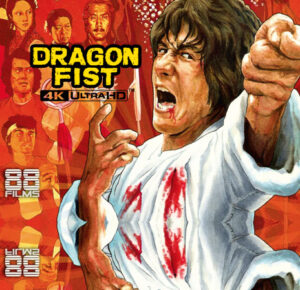



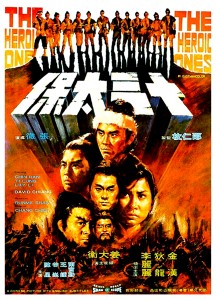
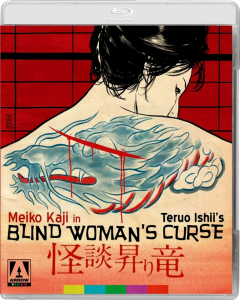
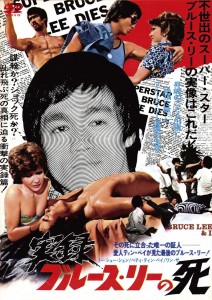
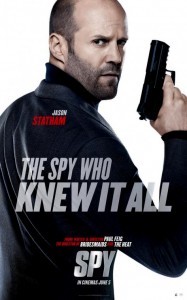
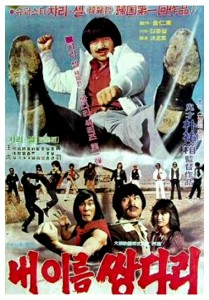
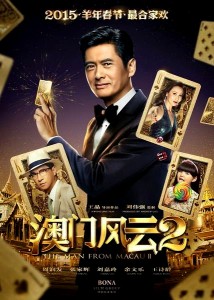


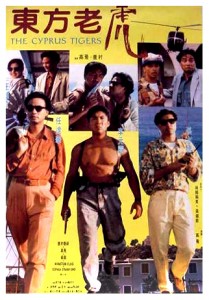
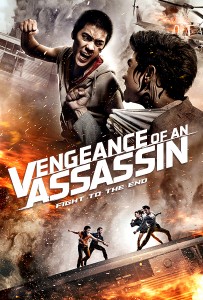
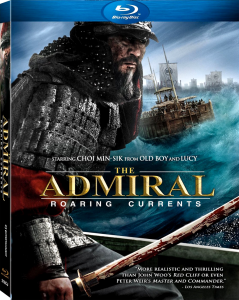
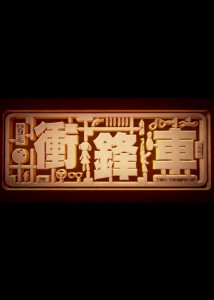
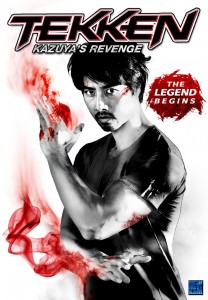
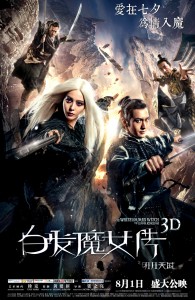
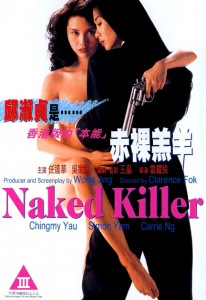



Be the 1st to Comment